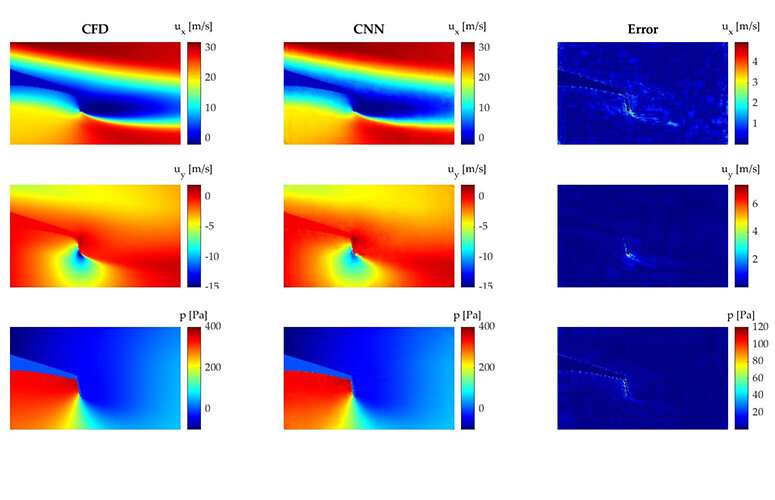
Research at the Vitoria-Gasteiz Faculty of Engineering of the UPV/EHU has used convolutional neural networks to predict airflow characteristics in the aerodynamic profiles of high-power wind turbines, and has shown that flow control devices can be studied using these neural networks, with tolerable errors and a reduction in computational time of four orders of magnitude. The study has been published in Scientific Reports.
Wind energy has become an important source of electricity generation and aims to achieve a cleaner, more sustainable energy model. However, in order to compete with conventional energy resources, the performance of wind turbines needs to be improved. To do this, flow control devices are deployed on the airfoils to improve the aerodynamic efficiency of the wind turbine rotors.
“So, with the same wind turbine you can produce more megawatts, the cost per megawatt hour is reduced, and when that is transferred, for example, to an offshore wind turbine (which is huge), means that the implementation cost is negligible, but the aerodynamic improvement may be in the region of 8 or 10 %,” explained Unai Fernández-Gámiz, lecturer in the Department of Nuclear Engineering and Fluid Mechanics of the UPV/EHU-University of the Basque Country.
Simulations involving Computational Fluid Dynamics (CFD) are the most popular method used to analyze devices of this type: “The software simulates the movement of fluids, which requires considerable computing capacity, i.e. very powerful computers and a lot of computing time,” explained Fernández-Gámiz. But in recent years, with the growth of artificial intelligence, the prediction of flow characteristics by means of neural networks has become increasingly popular; in this respect, the UPV/EHU student Koldo Portal-Porras deployed a convolutional neural network (CNN) that determines a series of parameters used for the flow control of wind turbines.
A fast, flexible, inexpensive tool
The results show that the CNN proposed for field prediction is able to accurately predict the main flow characteristics around the flow control device, displaying very minor errors. As for the aerodynamic coefficients, the proposed CNN is also able to predict them reliably, and is able to correctly predict both the trend and the values. “Compared with CFD simulations, the use of CNNs reduces computational time by four orders of magnitude,” said the researcher Portal-Porras. “Fast, almost immediate results have been achieved, with an error of 5–6% in some cases. A fairly tolerable error for an industry that primarily seeks rapid results,” added Fernández-Gámiz.
“First we launched CFD simulations using two different flow control devices (rotating microtabs and Gurney flaps), and that provided the output data, which we take as real and use to train the convolutional neural network,” explained Portal-Porras. “What we do is to insert the geometry as input and the results obtained via CFD as output. That way the network is trained, and then if we insert a different geometry into it with the results it produced previously, it is capable of predicting the new velocity and pressure fields.”
According to Fernández-Gámiz, Portal-Porras has come up with “a fast, flexible, inexpensive tool. Industry nowadays requires rapid solutions. To apply networks of this type you don’t really need big computers, computer clusters, etc. What is more, we have come up with a flexible tool, because it can be applied to any aerodynamic airfoil, to all types of device systems and even to other types of geometries.” Portal-Porras pointed out that the network is suitable for any type of wind turbine, “but the training data we input were for a specific aerodynamic airfoil. So, if you input a different aerodynamic airfoil, you would have to do the whole training process, in other words, insert the input and output data of the other wind turbine.”
Both agree on the importance of artificial intelligence: “This is a fundamental step if we want our industrial environment to be competitive. If we don’t get involved in artificial intelligence, we are not going to drive forward competitiveness on international markets.”
Bionic wing flaps improve wind energy efficiency
Koldo Portal-Porras et al, CNN-based flow control device modelling on aerodynamic airfoils, Scientific Reports (2022). DOI: 10.1038/s41598-022-12157-w
Citation:
Neural networks being used to improve the performance of high-power wind turbines (2022, August 8)
retrieved 8 August 2022
from https://techxplore.com/news/2022-08-neural-networks-high-power-turbines.html
This document is subject to copyright. Apart from any fair dealing for the purpose of private study or research, no
part may be reproduced without the written permission. The content is provided for information purposes only.
Stay connected with us on social media platform for instant update click here to join our Twitter, & Facebook
We are now on Telegram. Click here to join our channel (@TechiUpdate) and stay updated with the latest Technology headlines.
For all the latest Technology News Click Here
For the latest news and updates, follow us on Google News.
